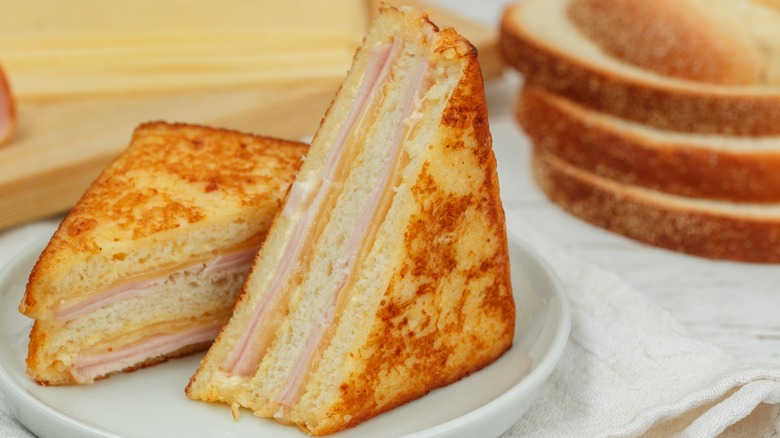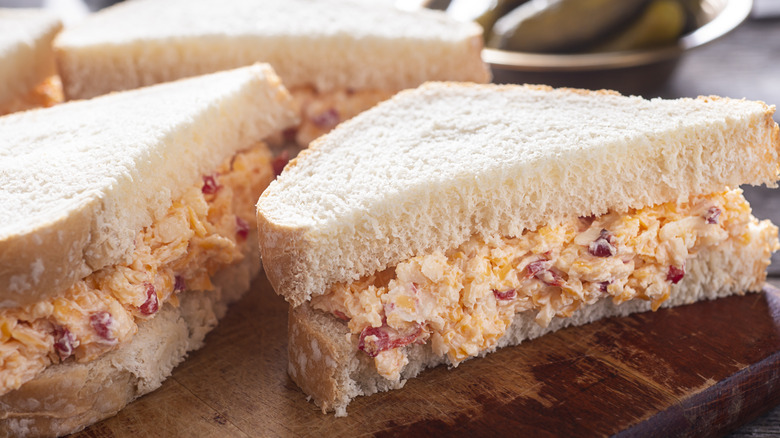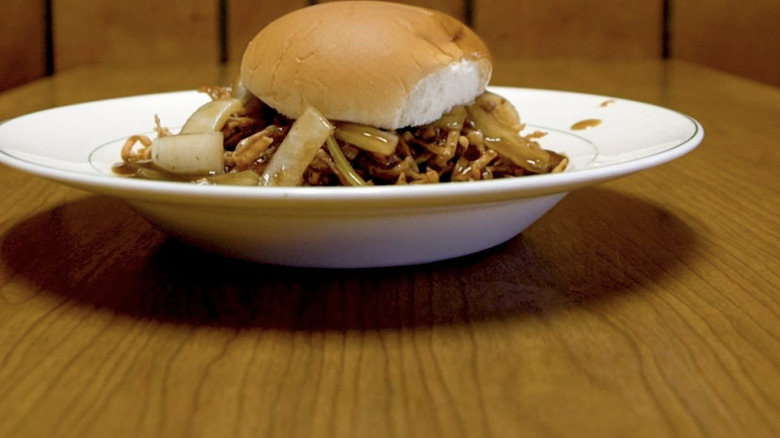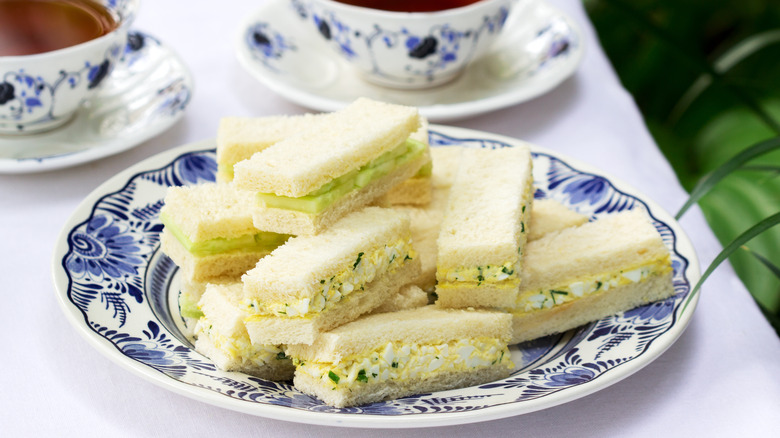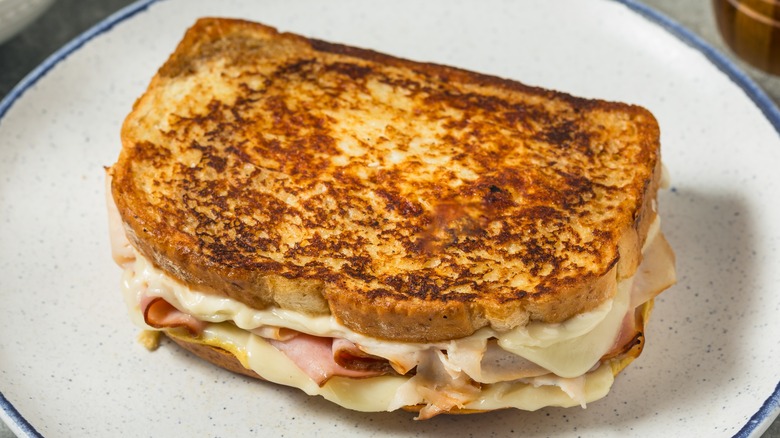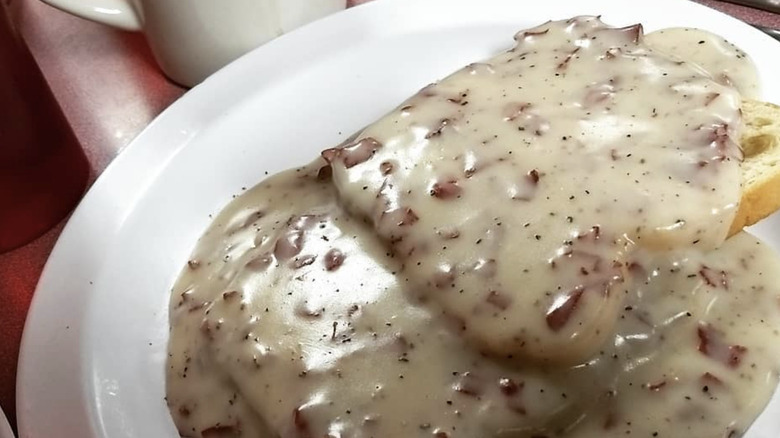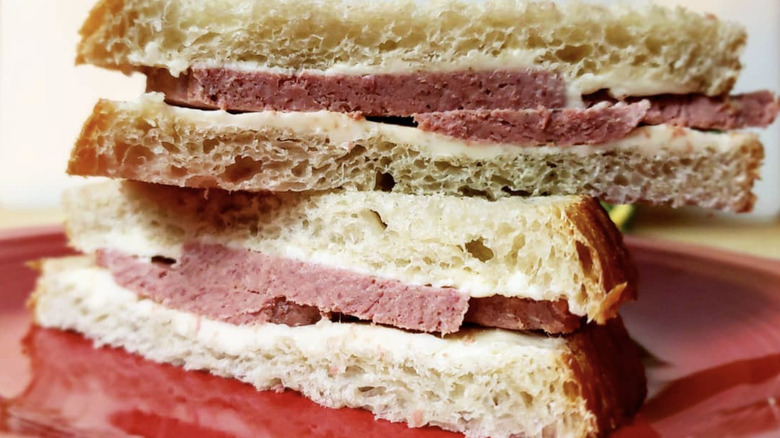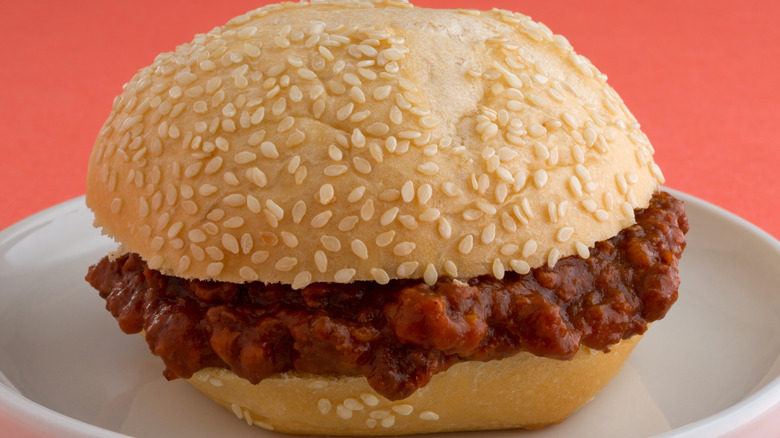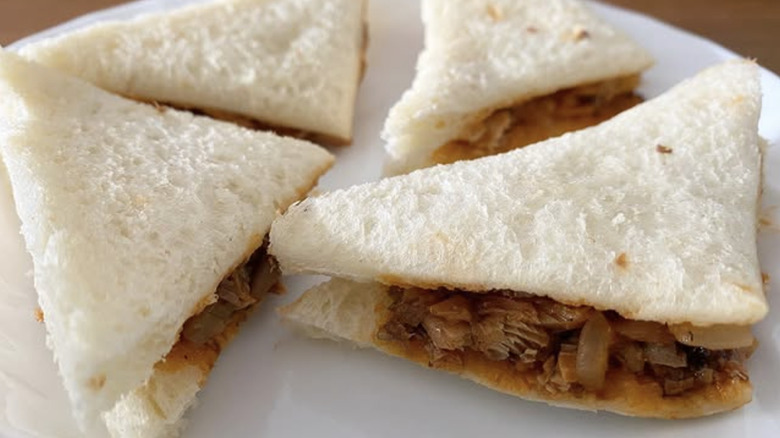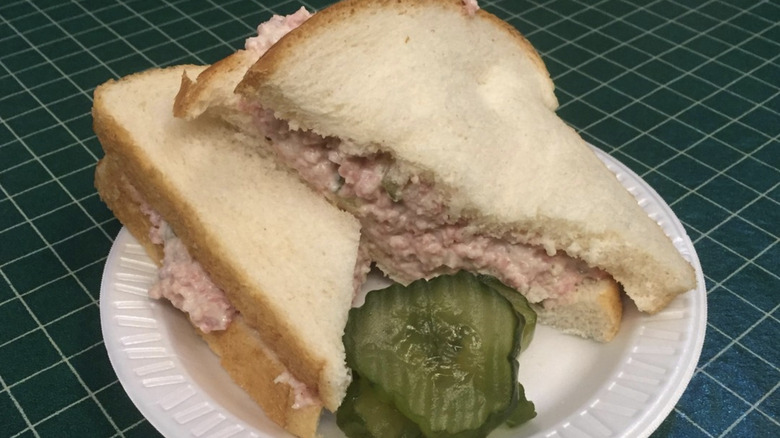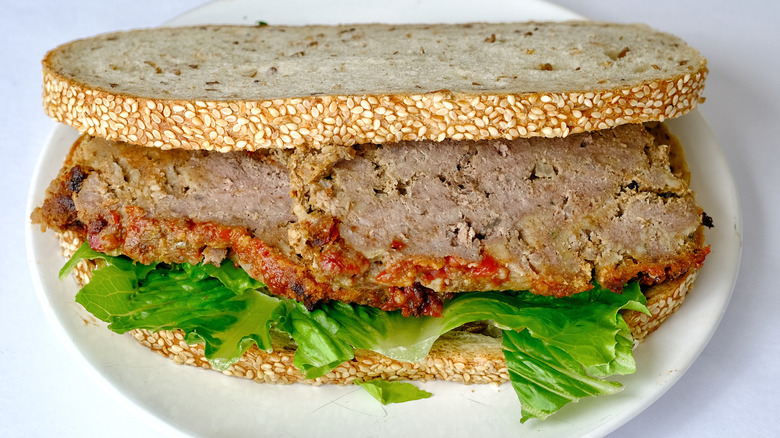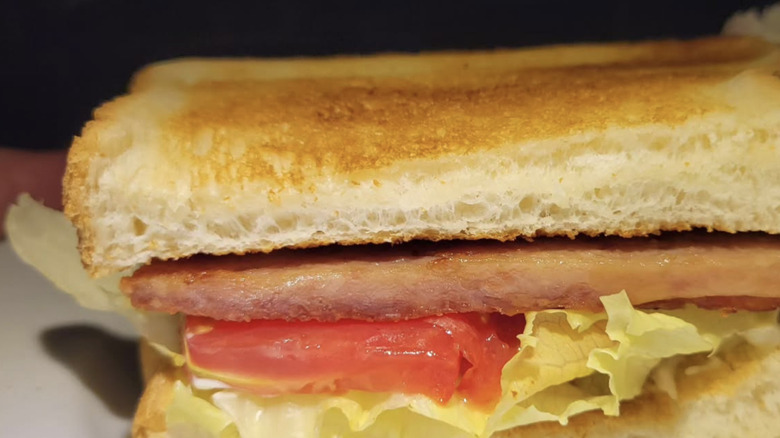12 Once-Popular Sandwiches Everyone Ate In The 1950s
We may receive a commission on purchases made from links.
Sandwiches have been relevant for centuries, and their venerable origins are subjected to much debate. What we do know is that John Montagu, the fourth Earl of Sandwich, championed them as the ultimate sustenance for multi-tasking gamblers in the late 1700s and their presence in world culture hasn't waned since. Much like music or fashion, popular food can be a reflection of the times — sandwiches have this telling quality. If you want to know a little about what day to day life was like in the 1950s, the sandwiches people ate are very much part of that story.
Sandwich bread is a blank slate that can go from simple to intricate with just a few swipes of well-intentioned fillings. A sandwich can be jazzed up to the near-excessive degree or pared down to little more than a slab of meat. This high-low approach was what popular sandwich recipes in the 1950s were all about.
Sandwiches from the 1950s also give us insight into how popular flavors evolve (or don't) over time. Certain retro ingredients fell out of fashion only to become new again, some never left, and others didn't stick around at all. Here, we'll explore how midcentury sandwich makers got it done, from elaborate eccentricities and comforting classics, to hearty lunch pail regulars and fancy finger foods.
Pimento cheese
Even if you're not a golf fan, you've probably heard of the Masters tournament in Augusta, Georgia. The elite golfing event draws upwards of 90,000 live spectators each year, and feeding a crowd of that size requires quick and easy sustenance — like some cold sandwiches perhaps. Like golf itself, the Masters is rooted in tradition. That's why the pimento cheese sandwich, which gained popularity at the Masters in the 1950s, remains a symbol of the tournament to this day.
American-grown pimento peppers got their start in 1916, when the Riegel family of Experiment, Georgia began harvesting and canning a domestic version of canned pimiento peppers from Spain. The creation of pimento cheese isn't definitively connected with a specific person or place, however, in the 1940s and 1950s, Americans embraced it as both a dip and a sandwich spread. This mixture of shredded cheddar cheese, pimentos, and either mayonnaise, cream cheese, or both was a beloved sandwich filling, especially in the South, where the Masters is held.
The first record of pimento cheese sandwiches at the Masters was in 1947, when Hodges and Ola Herndon began selling them on the golf course for 25 cents each. What the Herndons initiated at the Masters grew into a revered sandwich tradition that inextricably joined pimento cheese, the South, and golf together. Affordability is also part of the sandwich's legacy. Even in this economy, a pimento cheese sandwich at the Masters costs $1.50, the same price it's been since 2002.
Chow Mein
Every once in a while, a food comes around that's so tasty and unexpected, it captures public attention in a resounding way. The chow mein sandwich is one of these foods. There isn't much debate about the chow mein sandwich's origins: it came to be in Fall River, Massachusetts around the late 19th or early 20th century. Fall River was a major hub for the textile industry then, and Chinese immigrants operating restaurants in the area wanted to create a lunch item that appealed to the tastes of resident European-born factory workers.
By sandwiching crispy chow mein noodles, meat, and brown gravy between hamburger buns, the chow mein sandwich became something that looked familiar to Fall River's blue collar population while introducing locals to new flavors. The sandwich's unwavering following soared from there. Fall River eateries like Mee Sum restaurant became famous for serving heaping plates of bun-topped chow mein topped with Ho-Mee noodles supplied by Fall River's Oriental Chow Mein Company. By the 1950s, the chow mein sandwich was in demand elsewhere too, including Nathan's Famous in Brooklyn's Coney Island.
The chow mein sandwich is notably a sandwich that's heaped with so much filling it must be eaten with a fork. That's just part of its charm. Celebrity chef Emeril Lagasse, who grew up in Fall River, holds his memories of eating chow mein sandwiches so dear, he included a recipe for them in his 2015 cookbook "Essential Emeril."
Tea sandwiches
In the 1950s, the sight of an elegant tray of tea sandwiches might mean it's time to break out the cards and play some bridge, or that a garden party is underway. In most scenarios, delicately stacked finger sandwiches, or tea sandwiches as they're also known, were a sign you were in the presence of feminine energy. Tea sandwiches derive their name from the British tradition of afternoon tea — a high society affair of the Victorian age, originally conceptualized as a way to fuel up on caffeine and snacks in between lunch and dinner.
A classic tea sandwich's contents are in the style of sandwich "spreads", a malleable melange that can be evenly slathered between slices of untoasted bread. Once assembled, tea sandwiches are trimmed to a petite size with the crusts removed. Typical tea sandwiches of the 1940s and 1950s contained mayonnaise-based salads of shrimp, egg, and ham or veggie-forward spreads. Fillings like cream cheese with salmon or cucumber or pecans with mayonnaise and celery were published in recipe books geared toward ladies making lunch.
Some tea sandwiches of 1950s America also grant a glimpse into the era's finer points on female etiquette. The vegetable tea sandwich, created in Charlotte, North Carolina circa 1941 is one such example. The sandwich called for finely hand-minced veggies bound with mayonnaise and gelatin — but no garlic, herbs, or seeds that could linger on your breath or get stuck in your teeth.
Monte Cristo
Monte Cristo sandwiches of today are usually found on the menus of retro diners or lunch counters that stay in touch with their old-fashioned side. Back in the 1950s, Monte Cristos were all the rage, especially in restaurants, but they weren't exactly original. The Monte Cristo is a modified version of the Croque Monsieur, a hot sandwich made from ham and Gruyère cheese on soft bread (pain de mie) topped with béchamel sauce. The Croque Monsieur — French translation: Mister Crunch — gained notoriety in the cafés of France in the early 20th century. Its counterpart, the Croque Madame, adds a fried egg.
The Monte Cristo, named for French writer Alexandre Dumas' revenge classic "The Count of Monte Cristo," was officially given its name in "The Brown Derby Cookbook," a 1949 publication from Los Angeles restaurant, The Brown Derby. The recipe calls for three slices of buttered white bread, ham, chicken, and Swiss cheese. The sandwich, structurally similar to a Club sandwich, is dipped in egg and pan-fried before serving with a side of fruit jelly or cranberry sauce.
The Brown Derby launched the Monte Cristo into great fanfare, but earlier versions of the recipe already existed under different names. Egg-dipped ham and cheese sandwiches like the "Hot Ham Sandwich II" and the "French Sandwich" were published between 1929 and 1939. Widespread adaptations of the '50s-era Monte Cristo sandwich often come with two slices of bread instead of three and swaps the chicken for turkey.
Frosted sandwich loaf
Entertaining in the 1950s could skew a little over the top at times, and the frosted sandwich loaf is certainly something that falls into that category. Mid-century table spreads were a feast for the eyes as well as stomachs, which made the multi-tiered frosted sandwich loaf a desirable fixture for get togethers back then. Before you write off the frosted sandwich loaf as a fleeting trend of ambitious housewives, it's worth knowing that the inspiration it was built on traces back to a Scandinavian delicacy called smörgåstårta.
As its name and appearance suggests, the frosted sandwich loaf was created to be shared. The smörgåstårta, which translates to "sandwich cake", was popularized in Sweden and other parts of Northern Europe prior to the 1950s, however, its decadence was right in step with the decade's fanciful entertaining style. The sandwich loaf contains layers of bread and spreadable salad fillings like egg, chicken, or ham salad. The stacked sandwiches are encased in piped cream cheese or dressing and decorated with hard-boiled egg slices, cucumbers and various garnishes.
The frosted sandwich loaf's heyday in America hit a stride in the 1950s and 1960s but dwindled within a couple decades. In Scandinavian culture, the smörgåstårta lives on as a savory special occasion favorite. As tastes modernize, the frosted sandwich loaf of the 21st century focuses less on gaudy gimmicks and more on being its authentic, shareable self.
The SOS
Of all the popular sandwiches in the 1950s, few represented the trials and tribulations of the past quite like the "SOS". Prior to the decade that brought us the suburbs, the polio vaccine, and power steering, Americans had endured The Great Depression and two World Wars. When domestic food supplies were low, and in some cases rationed, people got creative with ways to stretch basic ingredients into recipes that could feed people a few times over. That's how creamed chipped beef entered the chat.
Creamed chipped beef on toast is a military meal centuries in the making. Its main components are dried cuts of lean, brined beef (usually beef round) and white gravy . The SOS may have been relegated to armed force fare had the Great Depression not cast its dark shadow over America's civilian population. Dried beef was something families could get their hands on, while a combination of evaporated milk, flour, and butter or margarine supplied the gravy. "SOS" was military speak for "save our souls," "same old slop," or "sh*t on a shingle," as it's most colloquially known.
Throughout the 1950s, the SOS sandwich was something that was oddly comforting to those who had lived through those tougher decades. It also rose to prevalence as a breakfast meal, often served alongside fried potatoes. The SOS isn't something people eat all the time anymore, but its storied reputation as a bare-bones sandwich is worth remembering.
Braunschweiger sandwich
When we talk about sandwiches of the 1950s it's impossible not to recognize the prolific nature of lunch pail food. Mid-century workers didn't stop at Subway on their lunch breaks, and for many, lunch counter pit stops weren't a regularity either. A lot of workers carried in lunch pails and their contents were exceedingly simple. The braunschweiger sandwich was a popular choice, especially for those with German heritage, which in the earlier parts of 20th century America, made up a large part of the ever-expanding population.
Braunschweiger is a smoked German sausage pâté in the same family as liverwurst. In the 1950s it was a comfort food as well as a pre and post-war lunchbox regular. A braunschweiger sandwich needed little more than a healthy smattering of the soft pâté bolstered by either butter, mayonnaise, or ketchup. Steadfast admirers of the braunschweiger sandwich play with its potential by heating it up and adding accoutrements like bacon, sweet onions or hard boiled egg. At its core, the braunschweiger sandwich is at its truest sans frills.
Sloppy Joes
Busy housewives of the 1950s needed to have a few no-frills recipe cards up their sleeves, which is where the Sloppy Joe fit in. The Sloppy Joe is a saucy, loose meat sandwich, meaning it's made of crumbled ground meat rather than the more conventional, tightly-packed ground meat burger. Loose meat sandwiches have roots in 1920s Midwestern luncheonettes, but the Sloppy Joe has less specific origins. Sloppy Joe's was the name of a 1930s bar in Havana, Cuba popular with the Hollywood elite and a 1940s restaurant in Key West, Florida, however the sandwich isn't distinctly tied to either.
The loose meat of a Sloppy Joe is mixed with seasoned tomato sauce, or sometimes a mixture of tomato and chili sauce or barbecue sauce. It was a school cafeteria staple by the 1950s and known to be a favorite of teenagers. Although making Sloppy Joes from scratch doesn't require much effort, brands like Libby's and Manwich further simplified the process by making pre-made cans of Sloppy Joe beef and sauce.
The messy nature of the sandwich is believed to be a motivating factor behind its name. Sloppy Joes are largely thought of as an unrefined, guilty pleasure of a sandwich, but some midcentury culinarians had a sweet spot for it. The legendary James Beard added a Sloppy Joe recipe to his 1972 cookbook "James Beard's American Cookery," admitting it was too popular and too current to overlook.
Sardine sandwich
In the realm of tinned fish, sardines tend to get overlooked a bit, but in the 1950s they were very much part of sandwich culture. Tinned sardines rose to prominence as an import from Portugal, Spain, and France. They were often referred to as pilchards, and in the countries from which they came, were typically served on toast. As tinned sardines became more and more relevant in the 20th century, fishery canning facilities in Maine became central to sardines' popularity in the U.S.
Sardines were a popular sandwich filling because they were cheap and delicious. Deli counters, cafeterias and diners far and wide featured sardine sandwiches on their menus. One well-known sardine sandwich recipe was the Maine sardine burger, which called for canned sardines, Corn Flakes, chopped parsley and onion, and lemon juice hand-packed into patties and fried in butter over slow heat. Sardines packed in tomato sauce were another popular offering of the 1950s, which could be heaped upon sliced bread or crackers with little effort to make a satisfying snack.
As the '50s drew to a close, sardines encountered big competition from another tinned fish sandwich fave: tuna fish. Slowly but surely, sardine sandwiches's popularity fell by the wayside. Sardine sandwiches are still around today, but you're more likely to find them in places outside the U.S. like Singapore and Malaysia.
Bologna salad
One sandwich that has struggled to stand the test of time is bologna salad. To the modern palate, it's a sandwich that is equal parts unhealthy and unappetizing. Yet for others, bologna salad sandwiches are an emblem of niche nostalgia. Like many old-fashioned foods, bologna salad caught on because it could feed a lot of people on the cheap. In 1950s America, families typically had more children than what we commonly see today — hence the term "baby boom". Although the baby boom era is often linked to post-war prosperity, many families struggled to get by.
Bologna salad was modeled after ham salad, another retro deli offering. It was widely adopted as a cheaper alternative, even earning the name "mock ham salad." Its preparation is similar to other mayo-based salads: chopped bologna and mayo are mixed with hard boiled eggs, pickles or relish, and seasoned to taste. Additions like onions or celery are also common.
Some vintage recipes call for the bologna salad to be blended into a smooth consistency, which could be part of why people are turned off by it these days. Even if it's mixed by hand with a fork, bologna salad has a soft, spongy consistency — an acquired taste indeed. Bologna salad sandwiches are still eaten in the 21st century, though most mentions of them usually come with a "back in the day" sentiment attached. Southerners have likened bologna salad sandwiches to a regional comfort food eaten in memory of a mid-century childhood.
Cold meatloaf sandwich
The 1950s put a major emphasis on family dinners, most of which featured a platter of meat at the center of the table. Meatloaf is one of the homiest main courses in existence, and its presence in '50s domestic cooking was at a high. Home cooking inevitably gives way to leftovers, and in the case of meatloaf, a sandwich was one of the choice ways to make use of yesterday's dinner.
If you have the time and resources, a hot meatloaf sandwich on toasted bread is a tempting route, but for the many '50s-era wives who packed family lunches, a cold meatloaf sandwich made the most sense. The beauty of a meatloaf sandwich lies in one's ability to cut a thick slice of meat to place in between bread. Since traditional meatloaf is chock full of breadcrumbs and doused with tomato sauce, a cold meatloaf sandwich doesn't beg for condiments or toppings. The sandwich bread doesn't require any finessing either — sturdy slices of white sandwich bread, sourdough, or wheat are harmonious vessels to a leftover centerpiece of beef.
Spam sandwich
Since 1937, Spam has polarized the public with a force few other foods can claim. The canned pork meat from Hormel Foods was marketed as the most shelf-stable, versatile "miracle meat" around — and it was affordable too. After Hormel shipped 150 million pounds of Spam overseas during World War II, it was pigeon-holed as a military-issued food, but thanks to Hormel's consistently robust print ads (with lots of recipe ideas), post-war families were buying Spam. A Spam sandwich, or "Spamwich," was a common offering, particularly for those who preferred to keep it simple.
Hormel's tagline, "Cold or hot Spam hits the spot" was true of Spam sandwiches. A couple Spam slices could stand in for ham or bologna on a cold sandwich with lettuce and tomato, while a hot Spam sandwich paired nicely with melted cheese. Hormel also advertised the ease of a grilled or fried Spam burger using the catchphrase, "Flippity-flop ... it's done — Spam burger on a bun!" (Hormel's creative team loved rhyming). When treated like a patty destined for sandwiches, Spam was given a more palatable light.
While much of middle America was trying to figure out whether to love or hate Spam, Asian populations abroad and stateside, took their love of Spam to teetering heights. Japanese immigrants in Hawaii created musubi, or Spam as sushi, now a regional classic. The Spam sandwich isn't slowing down either. The 21st century version of the Spamwich is often topped with fried egg.
